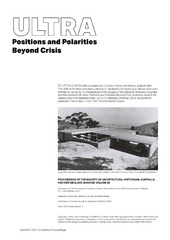The Role of Architectural History Research: Auckland’s NZI Building as William Gummer’s Attempt at Humanity
Конференцијски прилог (Објављена верзија)
Метаподаци
Приказ свих података о документуАпстракт
In response to the third thematic sub-stream of the 38th Annual
SAHANZ Conference, this paper will discuss the role of architectural
research in the architecture of Gummer and Ford, the Auckland-based
practice, often described as one of the most prolific bureaus in interwar
New Zealand. The paper is a fraction of a three-staged project, “Gummer
and Ford,” developed by a team of researchers from the Unitec Institute
of Technology in response to an event recognised as a milestone in the
New Zealand architectural calendar – the 2023 centenary of the firm’s
establishment.
This paper explores the design principles of William Gummer, the
principal designer of the firm. From 1914 to 1935, Gummer consistently
published his view that the goal of the architect was to cater to
humanity’s highest instincts. He was unwavering but vague on how this
is achieved; through composition, unity, contrast, proportion and scale,
appropriate use of materials is all needed to produce buildings of... good
character. But what did he really mean by this? A close reading of three
books Gummer considered invaluable to architectural students – The
Essentials of Composition as Applied to Art by John Vredenburgh Van
Pelt, Architectural Composition by Nathaniel Cortlandt Curtis, and The
Mistress Art by Reginald Bloomfield – offers a direct insight into the
influences behind his thinking about architecture and his architectural
production. Directly traceable to Gummer, the three titles include
clear, precise instructions on both the functional and artistic nature of
architectural design.
Interestingly, this paper employs a method not dissimilar to Gummer’s
design method. These books taken together, along with Gummer’s own
writing, a study of renderings and construction drawings, and close
observation of the buildings, an architectural analysis of Gummer’s
work becomes possible – it is what Gummer himself referred to as
Architectural Research. This historically focused study will bring a new
perspective to understanding the value and contribution of traditional
architects, not only in New Zealand but other English-speaking
countries.
Кључне речи:
William Gummer / Guardian Trust Building / “Architectural Research” / Research project / Gummer and FordИзвор:
Proceedings of the Society of Architectural Historians, Australia and New Zealand SAHANZ, 2022, 38, 533-543Издавач:
- Society of Architectural Historians Australia and New Zealand
Финансирање / пројекти:
- Research Project "Gummer and Ford"
Колекције
Институција/група
IFDTTY - CONF AU - Mađanović, Milica PY - 2022 UR - http://rifdt.instifdt.bg.ac.rs/123456789/2675 AB - In response to the third thematic sub-stream of the 38th Annual SAHANZ Conference, this paper will discuss the role of architectural research in the architecture of Gummer and Ford, the Auckland-based practice, often described as one of the most prolific bureaus in interwar New Zealand. The paper is a fraction of a three-staged project, “Gummer and Ford,” developed by a team of researchers from the Unitec Institute of Technology in response to an event recognised as a milestone in the New Zealand architectural calendar – the 2023 centenary of the firm’s establishment. This paper explores the design principles of William Gummer, the principal designer of the firm. From 1914 to 1935, Gummer consistently published his view that the goal of the architect was to cater to humanity’s highest instincts. He was unwavering but vague on how this is achieved; through composition, unity, contrast, proportion and scale, appropriate use of materials is all needed to produce buildings of good character. But what did he really mean by this? A close reading of three books Gummer considered invaluable to architectural students – The Essentials of Composition as Applied to Art by John Vredenburgh Van Pelt, Architectural Composition by Nathaniel Cortlandt Curtis, and The Mistress Art by Reginald Bloomfield – offers a direct insight into the influences behind his thinking about architecture and his architectural production. Directly traceable to Gummer, the three titles include clear, precise instructions on both the functional and artistic nature of architectural design. Interestingly, this paper employs a method not dissimilar to Gummer’s design method. These books taken together, along with Gummer’s own writing, a study of renderings and construction drawings, and close observation of the buildings, an architectural analysis of Gummer’s work becomes possible – it is what Gummer himself referred to as Architectural Research. This historically focused study will bring a new perspective to understanding the value and contribution of traditional architects, not only in New Zealand but other English-speaking countries. PB - Society of Architectural Historians Australia and New Zealand C3 - Proceedings of the Society of Architectural Historians, Australia and New Zealand SAHANZ T1 - The Role of Architectural History Research: Auckland’s NZI Building as William Gummer’s Attempt at Humanity VL - 38 SP - 533 EP - 543 DO - 10.55939/a4007piywz ER -
@conference{
author = "Mađanović, Milica",
year = "2022",
abstract = "In response to the third thematic sub-stream of the 38th Annual
SAHANZ Conference, this paper will discuss the role of architectural
research in the architecture of Gummer and Ford, the Auckland-based
practice, often described as one of the most prolific bureaus in interwar
New Zealand. The paper is a fraction of a three-staged project, “Gummer
and Ford,” developed by a team of researchers from the Unitec Institute
of Technology in response to an event recognised as a milestone in the
New Zealand architectural calendar – the 2023 centenary of the firm’s
establishment.
This paper explores the design principles of William Gummer, the
principal designer of the firm. From 1914 to 1935, Gummer consistently
published his view that the goal of the architect was to cater to
humanity’s highest instincts. He was unwavering but vague on how this
is achieved; through composition, unity, contrast, proportion and scale,
appropriate use of materials is all needed to produce buildings of good
character. But what did he really mean by this? A close reading of three
books Gummer considered invaluable to architectural students – The
Essentials of Composition as Applied to Art by John Vredenburgh Van
Pelt, Architectural Composition by Nathaniel Cortlandt Curtis, and The
Mistress Art by Reginald Bloomfield – offers a direct insight into the
influences behind his thinking about architecture and his architectural
production. Directly traceable to Gummer, the three titles include
clear, precise instructions on both the functional and artistic nature of
architectural design.
Interestingly, this paper employs a method not dissimilar to Gummer’s
design method. These books taken together, along with Gummer’s own
writing, a study of renderings and construction drawings, and close
observation of the buildings, an architectural analysis of Gummer’s
work becomes possible – it is what Gummer himself referred to as
Architectural Research. This historically focused study will bring a new
perspective to understanding the value and contribution of traditional
architects, not only in New Zealand but other English-speaking
countries.",
publisher = "Society of Architectural Historians Australia and New Zealand",
journal = "Proceedings of the Society of Architectural Historians, Australia and New Zealand SAHANZ",
title = "The Role of Architectural History Research: Auckland’s NZI Building as William Gummer’s Attempt at Humanity",
volume = "38",
pages = "533-543",
doi = "10.55939/a4007piywz"
}
Mađanović, M.. (2022). The Role of Architectural History Research: Auckland’s NZI Building as William Gummer’s Attempt at Humanity. in Proceedings of the Society of Architectural Historians, Australia and New Zealand SAHANZ Society of Architectural Historians Australia and New Zealand., 38, 533-543. https://doi.org/10.55939/a4007piywz
Mađanović M. The Role of Architectural History Research: Auckland’s NZI Building as William Gummer’s Attempt at Humanity. in Proceedings of the Society of Architectural Historians, Australia and New Zealand SAHANZ. 2022;38:533-543. doi:10.55939/a4007piywz .
Mađanović, Milica, "The Role of Architectural History Research: Auckland’s NZI Building as William Gummer’s Attempt at Humanity" in Proceedings of the Society of Architectural Historians, Australia and New Zealand SAHANZ, 38 (2022):533-543, https://doi.org/10.55939/a4007piywz . .



